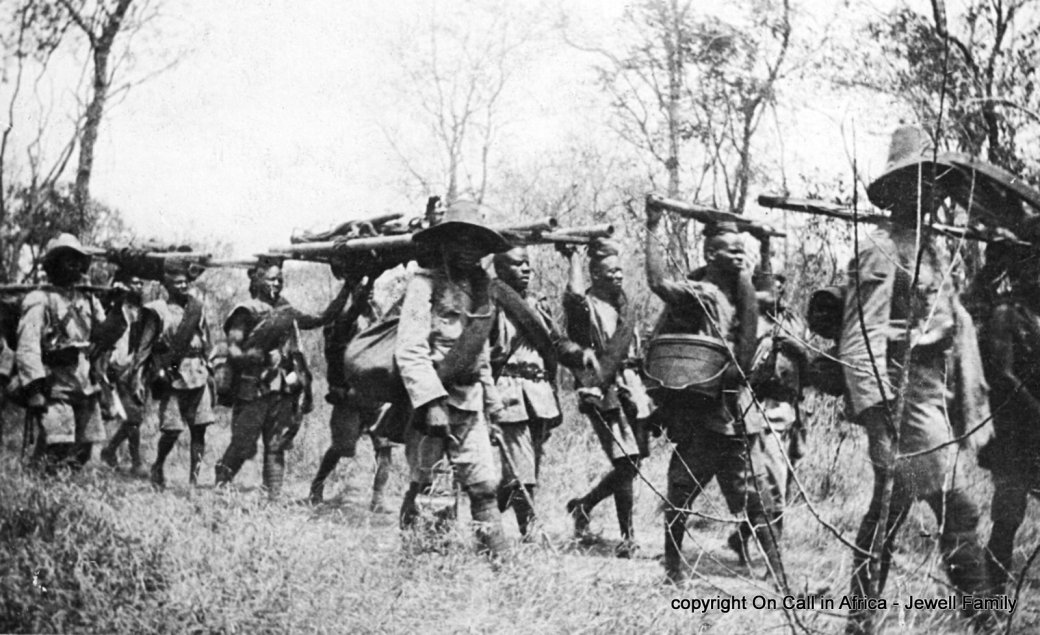Gold Coast Regiment arriving at Kibata
Some quotations from the short document by Edward Paice are instructive
How the Great War razed East Africa:
OVERVIEW:
The centenary of the outbreak of the “war to end all wars” in
August 1914 will be commemorated throughout Europe. The
suffering and loss of life during the conflict will loom large.
One signally important theatre of war is likely to remain
overlooked – Africa.
The East Africa campaign engulfed 750,000 square miles – an
area three times the size of the German Reich – as 150,000
Allied troops sought to defeat a German force whose strength
never exceeded 25,000. Its financial cost to the Allies was
comparable to that of the Boer War, Britain’s most expensive
conflict since the Napoleonic Wars. The official British death
toll exceeded 105,000 troops and military carriers. But it was
civilian populations throughout East Africa who suffered
worst of all in this final phase of the “Scramble for Africa”.
To call the Great War in East Africa a “sideshow” to the war
in Europe may be correct, but it is demeaning. The scale
and impact of the campaign were gargantuan. The troops,
carriers and millions of civilians caught up in the fighting in
East Africa should not be forgotten.
BATTLES
Mahiwa-Nyangao is certainly not listed among the better-known
battles of World War I. Even people living close by these settlements
on the B5 road, which runs inland from the southern Tanzanian port
of Lindi to Masasi, are unaware of the fighting between British and
German colonial troops that raged in their neighbourhood almost
a century ago. Yet here, in dense bush, one of the most ferocious
actions of the entire East Africa campaign of the Great War took
place over four days in October 1917.
Casualties among the 5,000-strong British force – including
three battalions from the Nigerian Brigade, three from the King’s
African Rifles, and the Bharatpur Infantry and 30th Punjabis from
India – were estimated at between one third and a half. The 16
companies of German Schutztruppen opposing them – about 2,000
men – sustained 25% casualties. Equally importantly at this stage
of the campaign, when all hopes of resupply from Germany had
evaporated, the German units expended nearly a million rounds of
precious ammunition during the battle.
The combined casualties at Mahiwa-Nyangao were comparable
to those of the bloodiest battle in the Anglo-South African, or
“Boer”, War of 1899–1902. In addition to being recognised in
contemporary military histories as “one of the greatest battles ever
fought in Africa”,1 Mahiwa-Nyangao also prompted the universal
acknowledgement that “the courage displayed on both sides by
the African soldier, be he Nigerian, King’s African Rifles, or German
askari was remarkable”.
MEMORIAL AND MEMORY
In East Africa, the memorials and graveyards of the fallen attract
little attention. Elsewhere Africa’s involvement in the Great War is
all but forgotten. There is no askari or carrier monument in London.
The best-known accounts of the war are fictional – C.S. Forester’s
The African Queen, Wilbur Smith’s Shout at the Devil and William
Boyd’s Booker Prize-nominated An Ice Cream War. If an episode is
recalled at the mention of the conflict, it is usually of the thrilling
adventure variety: Germany’s attempt to resupply the troops in
East Africa by Zeppelin in 1917; the extraordinary British naval
expedition to capture Lake Tanganyika; the thrills of the British
operation to sink the German cruiser Königsberg in the Rufiji Delta
in 1915; the determination and ingenious guerrilla tactics of the
German commander, von Lettow-Vorbeck. Perhaps the disastrous
British expeditionary force landing at Tanga in the first months of
the war, a precursor of the disaster at the Dardanelles in 1915, might
be vaguely familiar.
These episodes have their place. But they are corners of a much
larger canvas. They should not be allowed to obfuscate the reality
of war to the detriment of the memory of those who fought and the
suffering of the civilian population. The voices and memorials of the
Great War in East Africa are predominantly European. But African
combatants and carriers called upon to march twenty miles a day
for months on end, in searing heat and torrential rain, subsisting
on minimal rations and out of reach of medical resources, would
have concurred with the sentiment expressed by one young British
officer.
In 1914 Lt Lewis had witnessed the slaughter of every single
man in his half-battalion on the Western Front and had experienced
the horrors of trench warfare. Sixteen months later, in a letter to his
mother from the East African front, Lewis wrote: “I would rather be
in France than here”.
Please see How the Great War razed East Africa for references cited and much more detail.
